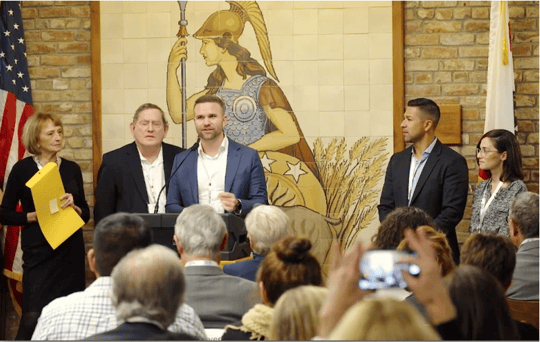Streamline’s Commitment to ADA Compliance
Streamline believes that Special District websites should be accessible to everyone!
Last updated: August 2025
Just as buildings must have wheelchair ramps, public websites must have special provisions for users with disabilities. The number of lawsuits rose 56% in 2021, and the penalties for noncompliance are rising—averaging $4,000 for an ADA claim in 2019 to $39,000 in 2022. It’s a situation that The Wall Street Journal calls “very perilous” in a recent article.
Because the majority of new actions are targeting organizations smaller than 30 million in revenue, special districts have emerged as being at risk, as they are often not aware of or prepared to meet web accessibility standards.
This article contains information on:
Understanding Accessibility Laws
The laws surrounding accessibility are complex and nuanced. There are a few layers of federal regulations further augmented by state regulations in some states. While more and more state laws are emerging with their own timelines and penalties, most districts do not realize that they are already liable for violations of federal laws, which comprise the majority of current actions.

Understanding Website Accessibility
When special districts have a website, it is required to be technically accessible and have policies and procedures for reporting and remediation.
The Americans with Disabilities Act (ADA)
Is a civil rights law that prohibits discrimination against individuals with disabilities. Title II of the ADA applies to public entities, which include special districts. This means that special districts have a legal obligation to ensure that their websites are accessible to individuals with disabilities.
The Web Content Accessibility Guidelines (WCAG)
A set of technical standards for web accessibility developed by the World Wide Web Consortium (W3C). Meeting these guidelines can help ensure that websites are accessible to people with a wide range of disabilities, including visual, auditory, physical, and cognitive disabilities. Special districts are required to meet WCAG 2.0 AA, and NSDC recommends that districts conform to WCAG 2.1 AA.
Making websites accessible is not just a legal obligation, it's also good for district communication.
Accessible websites can help reach a wider audience, improve user experience, and boost search engine optimization (SEO). In fact, Google has stated that accessibility is a ranking factor in its search algorithm.
Providing accessible websites is the right thing to do.
Everyone deserves equal access to information and services, regardless of their abilities. By making websites accessible, special districts can help promote inclusion and equity in their communities.
Streamline will protect you
Streamline cares about accessibility
The Streamline team has a long history of working on accessible websites. At the California Capital, Streamline’s CEO was presented with the “Vision Award” from Disability Rights California, the nation’s largest disability rights advocacy group, for their work on making websites more accessible to the public.

The award was presented by Jeffrey Thom, a board member, Stanford-trained attorney, and long-time champion of disability rights. In presenting the award, Jeffrey, who is blind, challenged the audience. ”Consider how frustrated you would be if you went to your favorite website and you got just a blue screen with nothing on it,” he said. “This is the reality for many users with disabilities.”
Meet our legal team
Streamline has partnered with two of the most recognized ADA defense attorneys in the United States—Martin Orlick and Stuart Tubis of Jeffer Mangels Butler & Mitchell LLP. They are intimately familiar with your website, the Streamline platform, and understand the unique nature of public sector Title II ADA complaints.


Streamline's Indemnification
Please review section 8 of the Streamline Terms of Services for information on Streamline's provided indemnity.
Our accessibility review process
Streamline conducts rigorous audits of its own platform in partnership with LevelAccess, one of the leading providers of web accessibility testing. This includes numerous real users with real disabilities on various accessible technologies (ATs) testing the site for issues.
Any identified issues are immediately addressed by our engineering team. Since accessibility best practices are constantly evolving, our work is never complete. If we find a widespread issue affecting multiple sites, we will work with those customers directly to resolve the issue in a timely manner.
Our rapid response process
Streamline is committed to a speedy response when either you or a member of your community finds an issue. Also, all communication is carefully documented in case the request for accommodation leads to a legal action or demand letter.
 Ongoing training
Ongoing training
Streamline offers CE-credit eligible ongoing accessibility training for special districts. Learn more or sign up for a class at getstreamline.com/accessibility.
How Streamline can help you
Streamline Accessibility Dashboard™
Streamline is the first and only company to offer ADA scanning built into its product for special districts.

What Accessibility Dashboard can do for your board members and management:
- Monthly comprehensive site scans
- Public accessibility policy landing page with up-to-date best practices for your state
- Website issue reporting form
- Scan results and remediation action reports
- Monthly board-ready compliance reports
- Check your PDFs for potential accessibility issues and give you easy options to remediate them
- Check your videos for closed captioning
- Check third-party content or linked content, such as an embedded map or widget, so please place custom HTML with care, or just ask us for help!
Why the person editing your website (e.g. a board secretary or communications director) will love it:
- AI-driven alt-text will automatically help you tag your images
- Color contrast boundaries, correctly-formatted headers, specific ADA-friendly fonts selected
- Mobile responsive designs that maintain ADA compliance for the 40% of people not on a desktop

Streamline’s accessibility assistant will guide you through specific fixes right on the page, without having to go to another system. With other systems, it can take a few hours to go through all the identified items and fix them on your site. With Streamline, remediation is right at your fingertips, with most identified problems being automatically resolved by the tool. Because Streamline is so easy to use, you can do the fixes yourself, or with help from our responsive team.

Comprehensive reports, policies, and workflows will be developed for your organization, bringing you into full compliance.
Pages
Pages now has an overview card at the top of the page that explains how many pages exist on the site, how many are accessible/inaccessible.

Images
Images has an overview section which details how many images exist on the site, how many are accessible & how many require review (not all images without alt text are inaccessible. If they are purely decorative it can be a better experience to omit alt text).

Embeds
Ability to find all embeds on your site in one easy place and review for accessibility

File & PDFs
-
Full visibility into all the files on your site
-
DocAccess: Instantly transcribes and transforms your PDFs into accessible, searchable, and translated content — no manual work required, and it costs just pennies per page.
-
Tools to prioritize and remediate your documents based on importance and compliance needs
-
“Click to fix” option: Send PDFs for traditional remediation at $7/page, returned in 5 business days with a certificate of accessibility
-
Advanced filtering by file type, status, accessibility, and more
-
Ability to Vault / Archive older documents that don’t need remediation


